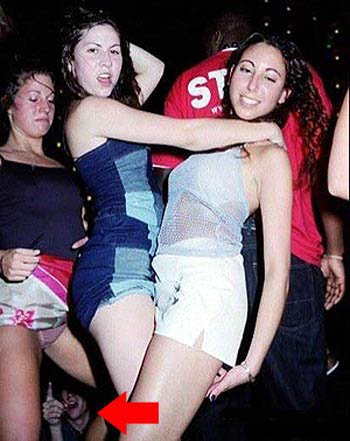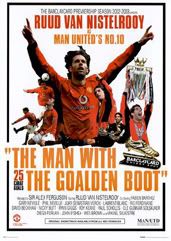

1 Arsenal's Champions League Parade
Thursday's Highbury to Islington Town Hall route had already been ordained; yellow signs had been posted to warn off non-Arsenal fans; the open-topped bus had been booked and a podium built for Arsène Wenger to parade the Champions League trophy to his adoring throng. Come Thursday, Islington was eerily quiet, the silence broken only by council employees dismantling a podium.
2 Australia's splash
Australia's women brilliantly won the 4x200m freestyle relay at the world swimming championships in 2001. In fact, Petria Thomas was so chuffed she jumped back into lane seven to thrash around with joy. Over in lane five, however, the Italians had not yet finished. The Australians were disqualified by what their coach claimed was a "kangaroo court”". It was only following the koala rules, set by wallaby judges.
3 Lindsey Jacobellis's tumble
Leading the 2006 Olympics snowboard cross at a canter, Jacobellis decided to climax with one last show-off: a hyper-difficult board-grab. She landed on the edge of her board and tumbled over, allowing Switzerland’s Tanja Frieden to take gold and relegating Jacobellis to silver. "I messed up," she shrugged. "Oh well. It happens."
4 Nigel Mansell's wave
The last lap of the 1991 Canadian Grand Prix. Nigel Mansell was so far ahead that he waved to the crowd to celebrate a glorious victory over his Brazilian arch-rival Nelson Piquet. Alas, in the process, the rather bulky Brummie accidentally switched off his Renault-Williams engine and stalled the car. He finished sixth, behind even Bertrand Gachot.
5 The US basketball team's time-out
In the 1972 Olympic final, the Americans went Cold War crazy when they led 50-49 with three seconds remaining and a time-out was called. As the Americans toasted their 63rd successive victory, the Soviet Union swept down court, Alexander Belov made a basket and his team took gold. The Americans childishly refused to accept their silvers.
6 Don Fox's conversion
With seconds remaining in the 1968 rugby league Challenge Cup final, a drenched Wakefield Trinity scored a heart-stopping try. A simple penalty conversion in front of the posts would secure them the "watersplash" final over Leeds. Exuberant Trinity fans celebrated as man of the match and dead-eye boot Don Fox stepped up. To their horror, Fox sliced the ball wide, handing victory to Leeds. As Fox squelched off, the very apotheosis of dejection, Eddie Waring uttered the immortal words: "He’s missed it. The poor lad."
7 Annika Sorenstam's chip
In 2000, the Solheim Cup at Loch Lomond was going rather well for Europe and Annika Sorenstam. On the final day she chipped in for birdie at the 13th and celebrated wildly. Until the Americans pointed out she had played out of turn and the shot had to be replayed. She missed.
8 Clive Thomas's whistle
Brazil were hugely relieved when Zico headed home a last-second winner against Sweden in their 1978 Group C game. They danced the samba, pretended it was carnival and lived up to every national stereotype, until referee Clive Thomas announced that he had already blown for time.
9 Roger Loughran's whip salute
With the recently turned professional Irish jockey Roger Loughran aboard, Central House led as he passed what the rider thought was the winning post at last year’s prestigious Paddy Power Dial-A-Bet Chase at Leopardstown. Loughran stood up and raised his whip to salute the crowd, but he hadn't won, he had passed a mere post, rather than the actual winning post. Central House finished third and Loughran was banned for 14 days, presumably for stupidity
10 Michael Knighton's ball juggling
To celebrate his takeover of Manchester United in 1989 for £20m, Michael Knighton "entertained" the Stretford End at Old Trafford with a display of ball-juggling that would have put Ralph Milne to shame. Tragically (for Knighton, if not United), Knighton’s backers, perhaps unable to take him seriously, pulled out of the deal and soon he was on his way to Carlisle United.
0 Fancy Pitting Your Footballing Knowledge Against Mine?

It seems everyone is trying to cash in on the World Cup, including Germany's biggest erotic retailer Beate Uhse. The chain has brought out an assortment of sex toys including "sporty vibrators", a ball stuffed with lingerie in various team colors, and a sport-themed porno film.
Erotic retailer Beate Uhse, whose brand name is as well known in Germany as Mercedes or Volkswagen, hopes its new range of products will attract World Cup tourists for whom the very German sight of sex shops prominently located in city centers may be a novelty.
0 Fancy Pitting Your Footballing Knowledge Against Mine?
0 Fancy Pitting Your Footballing Knowledge Against Mine?

1. Asteroid impact
Once a disaster scenario gets the cheesy Hollywood treatment, it's hard to take it seriously. But there is no question that a cosmic interloper will hit Earth, and we won't have to wait millions of years for it to happen. In 1908 a 200-foot-wide comet fragment slammed into the atmosphere and exploded over the Tunguska region in Siberia, Russia, with nearly 1,000 times the energy of the atomic bomb dropped on Hiroshima. Astronomers estimate similar-sized events occur every one to three centuries. Benny Peiser, an anthropologist-cum-pessimist at Liverpool John Moores University in England, claims that impacts have repeatedly disrupted human civilization. As an example, he says one killed 10,000 people in the Chinese city of Chi'ing-yang in 1490. Many scientists question his interpretations: Impacts are most likely to occur over the ocean, and small ones that happen over land are most likely to affect unpopulated areas. But with big asteroids, it doesn't matter much where they land. Objects more than a half-mile wide- which strike Earth every 250,000 years or so- would touch off firestorms followed by global cooling from dust kicked up by the impact. Humans would likely survive, but civilization might not. An asteroid five miles wide would cause major extinctions, like the one that may have marked the end of the age of dinosaurs. For a real chill, look to the Kuiper belt, a zone just beyond Neptune that contains roughly 100,000 ice-balls more than 50 miles in diameter. The Kuiper belt sends a steady rain of small comets earthward. If one of the big ones headed right for us, that would be it for pretty much all higher forms of life, even cockroaches.
2 .Gamma-ray burst
If you could watch the sky with gamma-ray vision, you might think you were being stalked by cosmic paparazzi. Once a day or so, you would see a bright flash appear, briefly outshine everything else, then vanish. These gamma-ray bursts, astrophysicists recently learned, originate in distant galaxies and are unfathomably powerful- as much as 10 quadrillion (a one followed by 16 zeros) times as energetic as the sun. The bursts probably result from the merging of two collapsed stars. Before the cataclysmal event, such a double star might be almost completely undetectable, so we'd likely have no advance notice if one is lurking nearby. Once the burst begins, however, there would be no missing its fury. At a distance of 1,000 light-years- farther than most of the stars you can see on a clear night- it would appear about as bright as the sun. Earth's atmosphere would initially protect us from most of the burst's deadly X rays and gamma rays, but at a cost. The potent radiation would cook the atmosphere, creating nitrogen oxides that would destroy the ozone layer. Without the ozone layer, ultraviolet rays from the sun would reach the surface at nearly full force, causing skin cancer and, more seriously, killing off the tiny photosynthetic plankton in the ocean that provide oxygen to the atmosphere and bolster the bottom of the food chain. All the gamma-ray bursts observed so far have been extremely distant, which implies the events are rare. Scientists understand so little about these explosions, however, that it's difficult to estimate the likelihood of one detonating in our galactic neighborhood.
3. Collapse of the vacuum
In the book Cat's Cradle, Kurt Vonnegut popularized the idea of "ice-nine," a form of water that is far more stable than the ordinary kind, so it is solid at room temperature. Unleash a bit of it, and suddenly all water on Earth transforms to ice-nine and freezes solid. Ice-nine was a satirical invention, but an abrupt, disastrous phase transition is a possibility. Very early in the history of the universe, according to a leading cosmological model, empty space was full of energy. This state of affairs, called a false vacuum, was highly precarious. A new, more stable kind of vacuum appeared and, like ice-nine, it quickly took over. This transition unleashed a tremendous amount of energy and caused a brief runaway expansion of the cosmos. It is possible that another, even more stable kind of vacuum exists, however. As the universe expands and cools, tiny bubbles of this new kind of vacuum might appear and spread at nearly the speed of light. The laws of physics would change in their wake, and a blast of energy would dash everything to bits. "It makes for a beautiful story, but it's not very likely," says Piet Hut of the Institute for Advanced Studies in Princeton, New Jersey. He says he worries more about threats that scientists are more certain of- such as rogue black holes.
4. Rogue black holes
Our galaxy is full of black holes, collapsed stellar corpses just a dozen miles wide. How full? Tough question. After all, they're called black holes for a reason. Their gravity is so strong they swallow everything, even the light that might betray their presence. David Bennett of Notre Dame University in Indiana managed to spot two black holes recently by the way they distorted and amplified the light of ordinary, more distant stars. Based on such observations, and even more on theoretical arguments, researchers guesstimate there are about 10 million black holes in the Milky Way. These objects orbit just like other stars, meaning that it is not terribly likely that one is headed our way. But if a normal star were moving toward us, we'd know it. With a black hole there is little warning. A few decades before a close encounter, at most, astronomers would observe a strange perturbation in the orbits of the outer planets. As the effect grew larger, it would be possible to make increasingly precise estimates of the location and mass of the interloper. The black hole wouldn't have to come all that close to Earth to bring ruin; just passing through the solar system would distort all of the planets' orbits. Earth might get drawn into an elliptical path that would cause extreme climate swings, or it might be ejected from the solar system and go hurtling to a frigid fate in deep space.
5. Giant solar flares
Solar flares- more properly known as coronal mass ejections- are enormous magnetic outbursts on the sun that bombard Earth with a torrent of high-speed subatomic particles. Earth's atmosphere and magnetic field negate the potentially lethal effects of ordinary flares. But while looking through old astronomical records, Bradley Schaefer of Yale University found evidence that some perfectly normal-looking, sunlike stars can brighten briefly by up to a factor of 20. Schaefer believes these stellar flickers are caused by superflares, millions of times more powerful than their common cousins. Within a few hours, a superflare on the sun could fry Earth and begin disintegrating the ozone layer (see #2). Although there is persuasive evidence that our sun doesn't engage in such excess, scientists don't know why superflares happen at all, or whether our sun could exhibit milder but still disruptive behavior. And while too much solar activity could be deadly, too little of it is problematic as well. Sallie Baliunas at the Harvard-Smithsonian Center for Astrophysics says many solar-type stars pass through extended quiescent periods, during which they become nearly 1 percent dimmer. That might not sound like much, but a similar downturn in the sun could send us into another ice age. Baliunas cites evidence that decreased solar activity contributed to 17 of the 19 major cold episodes on Earth in the last 10,000 years.
6. Reversal of Earth's magnetic field
Every few hundred thousand years Earth's magnetic field dwindles almost to nothing for perhaps a century, then gradually reappears with the north and south poles flipped. The last such reversal was 780,000 years ago, so we may be overdue. Worse, the strength of our magnetic field has decreased about 5 percent in the past century. Why worry in an age when GPS has made compasses obsolete? Well, the magnetic field deflects particle storms and cosmic rays from the sun, as well as even more energetic subatomic particles from deep space. Without magnetic protection, these particles would strike Earth's atmosphere, eroding the already beleaguered ozone layer (see #5). Also, many creatures navigate by magnetic reckoning. A magnetic reversal might cause serious ecological mischief. One big caveat: "There are no identifiable fossil effects from previous flips," says Sten Odenwald of the NASA Goddard Space Flight Center. "This is most curious." Still, a disaster that kills a quarter of the population, like the Black Plague in Europe, would hardly register as a blip in fossil records.
7. Flood-basalt volcanism
In 1783, the Laki volcano in Iceland erupted, spitting out three cubic miles of lava. Floods, ash, and fumes wiped out 9,000 people and 80 percent of the livestock. The ensuing starvation killed a quarter of Iceland's population. Atmospheric dust caused winter temperatures to plunge by 9 degrees in the newly independent United States. And that was just a baby's burp compared with what the Earth can do. Sixty-five million years ago, a plume of hot rock from the mantle burst through the crust in what is now India. Eruptions raged century after century, ultimately unleashing a quarter-million cubic miles of lava- the Laki eruption 100,000 times over. Some scientists still blame the Indian outburst, not an asteroid, for the death of the dinosaurs. An earlier, even larger event in Siberia occurred just about the time of the Permian-Triassic extinction, the most thorough extermination known to paleontology. At that time 95 percent of all species were wiped out.
Sulfurous volcanic gases produce acid rains. Chlorine-bearing compounds present yet another threat to the fragile ozone layer- a noxious brew all around. While they are causing short-term destruction, volcanoes also release carbon dioxide that yields long-term greenhouse-effect warming.The last big pulse of flood-basalt volcanism built the Columbia River plateau about 17 million years ago. We're ripe for another.
8. Global epidemics
If Earth doesn't do us in, our fellow organisms might be up to the task. Germs and people have always coexisted, but occasionally the balance gets out of whack. The Black Plague killed one European in four during the 14th century; influenza took at least 20 million lives between 1918 and 1919; the AIDS epidemic has produced a similar death toll and is still going strong. From 1980 to 1992, reports the Centers for Disease Control and Prevention, mortality from infectious disease in the United States rose 58 percent. Old diseases such as cholera and measles have developed new resistance to antibiotics. Intensive agriculture and land development is bringing humans closer to animal pathogens. International travel means diseases can spread faster than ever. Michael Osterholm, an infectious disease expert who recently left the Minnesota Department of Health, described the situation as "like trying to swim against the current of a raging river." The grimmest possibility would be the emergence of a strain that spreads so fast we are caught off guard or that resists all chemical means of control, perhaps as a result of our stirring of the ecological pot. About 12,000 years ago, a sudden wave of mammal extinctions swept through the Americas. Ross MacPhee of the American Museum of Natural History argues the culprit was extremely virulent disease, which humans helped transport as they migrated into the New World.
Human-Triggered Disasters
9. Global warming
The Earth is getting warmer, and scientists mostly agree that humans bear some blame. It's easy to see how global warming could flood cities and ruin harvests. More recently, researchers like Paul Epstein of Harvard Medical School have raised the alarm that a balmier planet could also assist the spread of infectious disease by providing a more suitable climate for parasites and spreading the range of tropical pathogens (see #8). That could include crop diseases which, combined with substantial climate shifts, might cause famine. Effects could be even more dramatic. At present, atmospheric gases trap enough heat close to the surface to keep things comfortable. Increase the global temperature a bit, however, and there could be a bad feedback effect, with water evaporating faster, freeing water vapor (a potent greenhouse gas), which traps more heat, which drives carbon dioxide from the rocks, which drives temperatures still higher. Earth could end up much like Venus, where the high on a typical day is 900 degrees Fahrenheit. It would probably take a lot of warming to initiate such a runaway greenhouse effect, but scientists have no clue where exactly the tipping point lies.
10. Ecosystem collapse
Images of slaughtered elephants and burning rain forests capture people's attention, but the big problem- the overall loss of biodiversity- is a lot less visible and a lot more serious. Billions of years of evolution have produced a world in which every organism's welfare is intertwined with that of countless other species. A recent study of Isle Royale National Park in Lake Superior offers an example. Snowy winters encourage wolves to hunt in larger packs, so they kill more moose. The decline in moose population allows more balsam fir saplings to live. The fir trees pull carbon dioxide out of the atmosphere, which in turn influences the climate. It's all connected. To meet the demands of the growing population, we are clearing land for housing and agriculture, replacing diverse wild plants with just a few varieties of crops, transporting plants and animals, and introducing new chemicals into the environment. At least 30,000 species vanish every year from human activity, which means we are living in the midst of one of the greatest mass extinctions in Earth's history. Stephen Kellert, a social ecologist at Yale University, sees a number of ways people might upset the delicate checks and balances in the global ecology. New patterns of disease might emerge (see #8), he says, or pollinating insects might become extinct, leading to widespread crop failure. Or as with the wolves of Isle Royale, the consequences might be something we'd never think of, until it's too late.
11. Biotech disaster
While we are extinguishing natural species, we're also creating new ones through genetic engineering. Genetically modified crops can be hardier, tastier, and more nutritious. Engineered microbes might ease our health problems. And gene therapy offers an elusive promise of fixing fundamental defects in our DNA. Then there are the possible downsides. Although there is no evidence indicating genetically modified foods are unsafe, there are signs that the genes from modified plants can leak out and find their way into other species. Engineered crops might also foster insecticide resistance. Longtime skeptics like Jeremy Rifkin worry that the resulting superweeds and superpests could further destabilize the stressed global ecosystem (see #9). Altered microbes might prove to be unexpectedly difficult to control. Scariest of all is the possibility of the deliberate misuse of biotechnology. A terrorist group or rogue nation might decide that anthrax isn't nasty enough and then try to put together, say, an airborne version of the Ebola virus. Now there's a showstopper.
12. Particle accelerator mishap
Theodore Kaczynski, better known as the Unabomber, raved that a particle accelerator experiment could set off a chain reaction that would destroy the world. Surprisingly, many sober-minded physicists have had the same thought. Normally their anxieties come up during private meetings, amidst much scribbling on the backs of used envelopes. Recently the question went public when London's Sunday Times reported that the Relativistic Heavy Ion Collider (RHIC) on Long Island, New York, might create a subatomic black hole that would slowly nibble away our planet. Alternately, it might create exotic bits of altered matter, called strangelets, that would obliterate whatever ordinary matter they met. To assuage RHIC's jittery neighbors, the lab's director convened a panel that rejected both scenarios as pretty much impossible. Just for good measure, the panel also dismissed the possibility that RHIC would trigger a phase transition in the cosmic vacuum energy (see #3). These kinds of reassurances follow the tradition of the 1942 "LA-602" report, a once-classified document that explained why the detonation of the first atomic bomb almost surely would not set the atmosphere on fire. The RHIC physicists did not, however, reject the fundamental possibility of the disasters. They argued that their machine isn't nearly powerful enough to make a black hole or destabilize the vacuum. Oh, well. We can always build a bigger accelerator.
13. Nanotechnology disaster
Before you've even gotten the keyboard dirty, your home computer is obsolete, largely because of incredibly rapid progress in miniaturizing circuits on silicon chips. Engineers are using the same technology to build crude, atomic-scale machines, inventing a new field as they go called nanotechnology. Within a few decades, maybe sooner, it should be possible to build microscopic robots that can assemble and replicate themselves. They might perform surgery from inside a patient, build any desired product from simple raw materials, or explore other worlds. All well and good if the technology works as intended. Then again, consider what K. Eric Drexler of the Foresight Institute calls the "grey goo problem" in his book Engines of Creation, a cult favorite among the nanotech set. After an industrial accident, he writes, bacteria-sized machines, "could spread like blowing pollen, replicate swiftly, and reduce the biosphere to dust in a matter of days." And Drexler is actually a strong proponent of the technology. More pessimistic souls, such as Bill Joy, a cofounder of Sun Microsystems, envision nano-machines as the perfect precision military or terrorist tools.
14. Environmental toxins
From Donora, Pennsylvania, to Bhopal, India, modern history abounds with frightening examples of the dangers of industrial pollutants. But the poisoning continues. In major cities around the world, the air is thick with diesel particulates, which the National Institutes of Health now considers a carcinogen. Heavy metals from industrial smokestacks circle the globe, even settling in the pristine snows of Antarctica. Intensive use of pesticides in farming guarantees runoff into rivers and lakes. In high doses, dioxins can disrupt fetal development and impair reproductive function- and dioxins are everywhere. Your house may contain polyvinyl chloride pipes, wallpaper, and siding, which belch dioxins if they catch fire or are incinerated. There are also the unknown risks to think about. Every year NIH adds to its list of cancer-causing substances- the number is up to 218. Theo Colburn of the World Wildlife Fund argues that dioxins and other, similar chlorine-bearing compounds mimic the effects of human hormones well enough that they could seriously reduce fertility. Many other scientists dispute her evidence, but if she's right, our chemical garbage could ultimately threaten our survival.
Willful Self-Destruction
15. Global war
Together, the United States and Russia still have almost 19,000 active nuclear warheads. Nuclear war seems unlikely today, but a dozen years ago the demise of the Soviet Union also seemed rather unlikely. Political situations evolve; the bombs remain deadly. There is also the possibility of an accidental nuclear exchange. And a ballistic missile defense system, given current technology, will catch only a handful of stray missiles- assuming it works at all. Other types of weaponry could have global effects as well. Japan began experimenting with biological weapons after World War I, and both the United States and the Soviet Union experimented with killer germs during the cold war. Compared with atomic bombs, bioweapons are cheap, simple to produce, and easy to conceal. They are also hard to control, although that unpredictability could appeal to a terrorist organization. John Leslie, a philosopher at the University of Guelph in Ontario, points out that genetic engineering might permit the creation of "ethnic" biological weapons that are tailored to attack primarily one ethnic group (see #11).
16. Robots take over
People create smart robots, which turn against us and take over the world. Yawn. We've seen this in movies, TV, and comic books for decades. After all these years, look around and still- no smart robots. Yet Hans Moravec, one of the founders of the robotics department of Carnegie Mellon University, remains a believer. By 2040, he predicts, machines will match human intelligence, and perhaps human consciousness. Then they'll get even better. He envisions an eventual symbiotic relationship between human and machine, with the two merging into "postbiologicals" capable of vastly expanding their intellectual power. Marvin Minsky, an artificial-intelligence expert at MIT, foresees a similar future: People will download their brains into computer-enhanced mechanical surrogates and log into nearly boundless files of information and experience. Whether this counts as the end of humanity or the next stage in evolution depends on your point of view. Minsky's vision might sound vaguely familiar. After the first virtual-reality machines hit the marketplace around 1989, feverish journalists hailed them as electronic LSD, trippy illusion machines that might entice the user in and then never let him out. Sociologists fretted that our culture, maybe even our species, would whither away. When the actual experience of virtual reality turned out to be more like trying to play Pac-Man with a bowling ball taped to your head, the talk died down. To his credit, Minsky recognizes that the merger of human and machine lies quite a few years away.
17. Mass insanity
While physical health has improved in most parts of the world over the past century, mental health is getting worse. The World Health Organization estimates that 500 million people around the world suffer from a psychological disorder. By 2020, depression will likely be the second leading cause of death and lost productivity, right behind cardiovascular disease. Increasing human life spans may actually intensify the problem, because people have more years to experience the loneliness and infirmity of old age. Americans over 65 already are disproportionately likely to commit suicide. Gregory Stock, a biophysicist at the University of California at Los Angeles, believes medical science will soon allow people to live to be 200 or older. If such an extended life span becomes common, it will pose unfathomable social and psychological challenges. Perhaps 200 years of accumulated sensations will overload the human brain, leading to a new kind of insanity or fostering the spread of doomsday cults, determined to reclaim life's endpoint. Perhaps the current trends of depression and suicide among the elderly will continue. One possible solution- promoting a certain kind of mental well-being with psychoactive drugs such as Prozac- heads into uncharted waters. Researchers have no good data on the long-term effects of taking these medicines.
A Greater Force Is Directed Against Us
18. Alien invasion
At the SETI Institute in Mountain View, California, a cadre of dedicated scientists sifts through radio static in search of a telltale signal from an alien civilization. So far, nothing. Now suppose the long-sought message arrives. Not only do the aliens exist, they are about to stop by for a visit. And then . . . any science-fiction devotee can tell you what could go wrong. But the history of human exploration and exploitation suggests the most likely danger is not direct conflict. Aliens might want resources from our solar system (Earth's oceans, perhaps, full of hydrogen for refilling a fusion-powered spacecraft) and swat us aside if we get in the way, as we might dismiss mosquitoes or beetles stirred up by the logging of a rain forest. Aliens might unwittingly import pests with a taste for human flesh, much as Dutch colonists reaching Mauritius brought cats, rats, and pigs that quickly did away with the dodo. Or aliens might accidentally upset our planet or solar system while carrying out some grandiose interstellar construction project. The late physicist Gerard O'Neill speculated that contact with extraterrestrial visitors could also be socially disastrous. "Advanced western civilization has had a destructive effect on all primitive civilizations it has come in contact with, even in those cases where every attempt was made to protect and guard the primitive civilization," he said in a 1979 interview. "I don't see any reason why the same thing would not happen to us."
19. Divine intervention
Judaism has the Book of Daniel; Christianity has the Book of Revelation; Islam has the coming of the Mahdi; Zoroastrianism has the countdown to the arrival of the third son of Zoroaster. The stories and their interpretations vary widely, but the underlying concept is similar: God intervenes in the world, bringing history to an end and ushering in a new moral order. Apocalyptic thinking runs at least back to Egyptian mythology and right up to Heaven's Gate and Y2K mania. More worrisome, to the nonbelievers at least, are the doomsday cults that prefer to take holy retribution into their own hands. In 1995, members of the Aum Shinri Kyo sect unleashed sarin nerve gas in a Tokyo subway station, killing 12 people and injuring more than 5,000. Had things gone as intended, the death toll would have been hundreds of times greater. A more determined group armed with a more lethal weapon- nuclear, biological, nanotechnological even- could have done far more damage.
20. Someone wakes up and realizes it was all a dream
Are we living a shadow existence that only fools us into thinking it is real? This age-old philosophical question still reverberates through cultural thought, from the writings of William S. Burrows to the cinematic mind games of The Matrix. Hut of the Institute of Advanced Studies sees an analogy to the danger of the collapse of the vacuum. Just as our empty space might not be the true, most stable form of the vacuum, what we call reality might not be the true, most stable form of existence. In the fourth century B.C., Taoist philosopher Chuang Tzu framed the question in more poetic terms. He described a vivid dream. In it, he was a butterfly who had no awareness of his existence as a person. When he awoke, he asked: "Was I before Chuang Tzu who dreamt about being a butterfly, or am I now a butterfly who dreams about being Chuang Tzu?" - with additional research by Diane Martindale
0 Fancy Pitting Your Footballing Knowledge Against Mine?

This.Is.Old.Trafford shall be commemorating a week of Canto-mania in honour of a true United, legend.
Long Live The King!
Tackled By The Red Devil at 6:39 PM,0 Fancy Pitting Your Footballing Knowledge Against Mine?
 This is the ultimate Find Her Differences game. Spot the difference in 210 sets of pictures! In this game you will see pictures of the most popular girls and celebs. In the future we will add even more sets of pictures to this game!
This is the ultimate Find Her Differences game. Spot the difference in 210 sets of pictures! In this game you will see pictures of the most popular girls and celebs. In the future we will add even more sets of pictures to this game!0 Fancy Pitting Your Footballing Knowledge Against Mine?

Create Your Own Religion In 10 Easy Steps
1) Create a God. One with a catchy name is best. Should be simple and out of the ordinary, but not too far out that people can't remember it.
In our example we will create "The Great God Lardicus". It has "Lard" in the name which people already associate with fast food. It has "-icus" at the end of it, which sounds Greek, so it must be old and have centuries of tradition behind it.
0 Fancy Pitting Your Footballing Knowledge Against Mine?

Surely not! Sheesh! Unless theyre judging the mariah carey legs of 1999, then sure, even i'd have no choice but to agree. But come on! Judging by the pict up there, its nothing but cellulite central! Well anyhow, check out a vid of mariah's legs at their peak HERE. Tackled By The Red Devil at 8:04 PM,
0 Fancy Pitting Your Footballing Knowledge Against Mine?
Starters
Egg on Face
Seasoned Hash
Frogs legs (past their best)
Spanish Surprise (well beaten)
Main course
Humble Pie
Chump Chops
French (has) Beans
Manager's Beef (not rare)
Catch of the Day - big lemon Sol (gutted)
NB: everything is imported, nothing is home grown.
Dessert
Sour Grapes (may be hard to swallow)
Fruitless Tarts
Raspberry Fools
Hard Cheese
Drinks
Bitter
Little Spirit
French Whine
Cabernet Empty 2006
Champagne - sorry none ordered
STRICTLY NO DOUBLES OR TREBLES
NB: drinks should be consumed from glasses as there will be no cups this year.
Guest speaker:
Sir Alex Ferguson - "What it's like to win the European Cup"
And for entertainment we've got a special one time, never seen before footage entitled, "A Celebration of Arsenal in The Champions League." Here's a sneak peek:
0 Fancy Pitting Your Footballing Knowledge Against Mine?









Fancy a game of cricket? Emmanuel Eboue's incredible rolling motion makes him a perfect cricket ball! Watch closely as he rolls across the the boudanry for a 4!
0 Fancy Pitting Your Footballing Knowledge Against Mine?
0 Fancy Pitting Your Footballing Knowledge Against Mine?
 Tackled By The Red Devil at 11:52 AM,
Tackled By The Red Devil at 11:52 AM,0 Fancy Pitting Your Footballing Knowledge Against Mine?

Tour Of South Africa
Saturday, July 15 – Orlando Pirates v Manchester United (Durban).
Tuesday, July 18 – Kaizer Chiefs v Manchester United (Cape Town).
Thursday, July 20 – Kaizer Chiefs v Orlando Pirates (Rustenburg).
Saturday, July 22 – Manchester United v winners of July 20 game (Pretoria).
Amsterdam Tournament
Friday August 4th. 19:00; Galatasaray - Manchester United
Friday August 4th. 21:15; Ajax - FC Porto
Saturday August 5th 19:00; FC Porto - Galatasaray
Saturday August 5th 21:15; Ajax - Manchester United
0 Fancy Pitting Your Footballing Knowledge Against Mine?
 Manchester United owner Malcolm Glazer is back in hospital after suffering a second stroke.
Manchester United owner Malcolm Glazer is back in hospital after suffering a second stroke.The 77-year-old American businessman was only released from the prestigious Cleveland Clinic in Florida on April 23 after suffering the initial attack. Although sources close to the Glazer camp insist his life is not in any danger, his speech and mobility are impaired and the treatment is likely to take weeks.
"Doctors expect my father to return home in the next few weeks," said Glazer's son Joel. "As a result of this stroke, his rehabilitation period will be longer and more challenging. Our family appreciates all the support and warm wishes that we have received."
Just as they did when news of Glazer's first stroke was confirmed last month, the family continue to insist their father's health problems will have no impact on the day-to-day running of Old Trafford.
At no stage since the takeover has Glazer been involved in any of the major decisions, as he is content to let sons Joel, Ave and Bryan liaise with Manchester-based directors Nick Humby, Andy Anson and chief executive David Gill.
"It is business as usual as far as Manchester United are concerned," said the Glazer source. "There will be absolutely no change at the club whatsoever."

Well he cant say he was'nt warned!

Fuckin yank! Should'a stuck with fuckin baseball or the nfl!
Tackled By The Red Devil at 11:25 AM,0 Fancy Pitting Your Footballing Knowledge Against Mine?










About This Blog
This.Is.Old.Trafford's First Ever Post
This.Is.Old.Trafford Classics
Cybersex Gone Horribly Wrong (Part 1)
What A Man Would Do If He Had A Vagina For 1 Day
This.Is.Old.Trafford Archives
2005-09-25
2005-10-02
2005-10-09
2005-10-16
2005-10-23
2005-10-30
2005-11-06
2005-11-13
2005-11-20
2005-11-27
2005-12-04
2005-12-11
2005-12-18
2005-12-25
2006-01-01
2006-01-08
2006-01-15
2006-01-22
2006-02-05
2006-02-19
2006-02-26
2006-03-05
2006-03-12
2006-03-19
2006-03-26
2006-04-02
2006-04-09
2006-04-16
2006-04-23
2006-04-30
2006-05-07
2006-05-14
2006-05-21
2006-05-28
2006-06-04
2006-06-11
2006-06-18
2006-06-25
2006-07-02
2006-07-09
2006-07-16
2006-07-30
2006-08-06
2006-08-13
2006-08-20
2006-08-27
2006-09-03
2006-09-10
2006-09-17
2006-09-24
2006-10-01
2006-10-08
2006-10-15
2006-10-22
2006-10-29
2006-11-05
2006-11-12
2006-11-19
2006-11-26
2006-12-03
2006-12-10
2006-12-17
2006-12-24
2006-12-31
2007-01-21
2007-01-28
2007-02-04
2007-03-04
2007-03-18
2007-04-08
2007-04-15
2007-04-22
2007-04-29
2007-05-06
2007-05-13
2007-10-07
This.Is.Old.Trafford Fanclub
This.Is.Old.Trafford Shoutbox

























































 <<
#
BolehBlogs
?
>>
<<
#
BolehBlogs
?
>>

